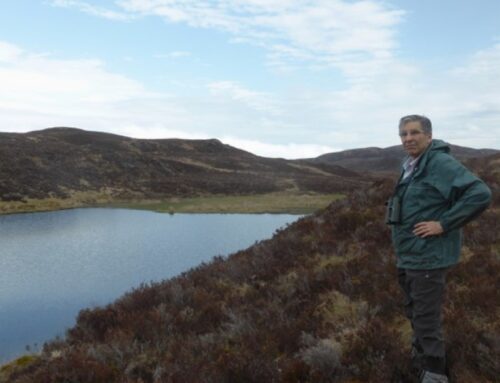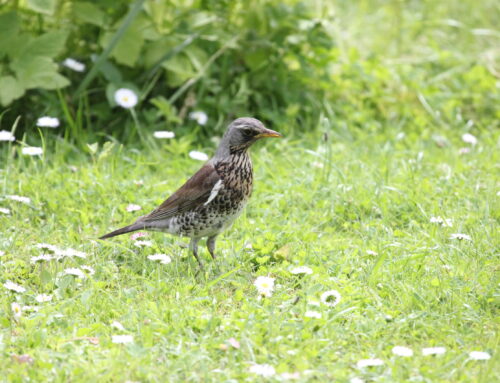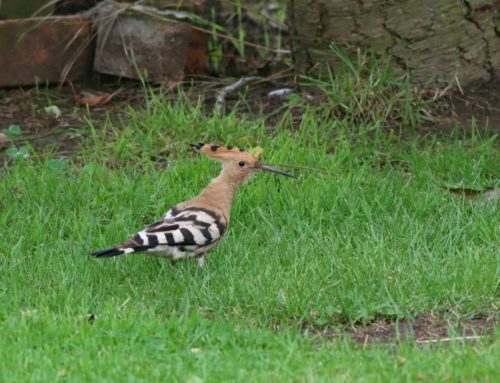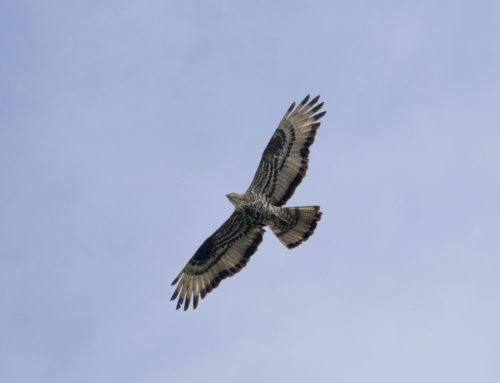Rare breeding bird recording – the Dorset way
The records that the Rare Breeding Birds Panel collates to report on the status of the UK’s rare breeding birds, and archive for conservation and research uses, come from many sources, such as conservation projects, ringing and nest recording and reserves monitoring. The most important source are the records from birdwatchers, compiled for us by the UK’s network of county bird recorders – around two-thirds of the data we receive comes from their diligent work. In this blog Shaun Robson, the rare breeding bird recorder for Dorset Bird Club, gives us an overview of the work that goes into compiling their annual return to the RBBP.

Dartford Warbler; RSPB Images
In 2018 or thereabouts Dorset Bird Club was in the midst of a rebuild of its recording team. Like many counties we realised that there was too much work for one person and we therefore sought to share the load. Over a number of iterations, we developed three principal roles, splitting the County Recorder role into 3 parts.
- one looking after rare and scarce birds and liaising with BBRC and the scarce migrants report editors;
- one looking after general bird records and our database; and
- the third looking after rare breeding bird data and liaising with RBBP.
When the music stopped, I agreed to pick up the third role. The first acts as the actual Recorder, with the second two operating under the title of Assistant Recorder.
Working in the field of bird recording wasn’t new to me. I had been Dorset County Recorder for five years at the end of the 90’s and had been on the county records panel for fifteen years or so up until the end of the noughties. However, I was soon to recognise that much had changed since those days of paper submissions and snail mail.
My induction into my new role got off to a great start when Mark Holling, then secretary of RBBP, arranged a regional south-west meeting of recorders to discuss the work of the panel. This left me in no doubt just how much things had changed since I last did the role. Back then, my submissions to RBBP on behalf of Dorset was little more than a last-minute thought with a list of species with the number of estimated pairs in the county. It was clear now that data standards and the level of detail were much more sophisticated and this was going to require a lot more thought.
We, in common with many other counties, had started to slip behind the calendar. It was 2018 but our 2015 data had not been processed. I recognised we would not be able to make an ideal submission straight away, or catch up immediately, but that doing the best we could with what we had was at least a start. Both the formation of the specific role and the step of making a submission also sent a clear message to all interested parties – “This was an important purpose of the club and Dorset wanted to be part of, and seen to be part of, the national recording framework”. With this established, my plan was to try and introduce incremental improvement year on year and move towards the ideal that Mark had described.
Dorset is not perhaps unique, but it is unusual. For a small geographic area, it has a significant number of local groups, clubs and patch workers each conducting their own recording. We have a Bird Observatory, a local ornithological group, an area-based recording and engagement based bird charity, eight local patch annual bird reports together with the whole suite of NGO’s that are present in many areas of the UK. However, due to our physical geography, the majority of these covered our coastal honeypots in the south of the county with the north being largely ignored by Dorset’s birders. We lack a county wide ringing group or a county-wide raptor study group.

Honey-buzzard; Jamie Partridge
Data from many of the above sources was the bedrock of our available records. BirdTrack was growing and e-Bird records, now increasingly important, were just starting to appear. Analysis of these records soon revealed that information about breeding status was very thin. Ascertaining even basic information such as breeding evidence and precise location took some research and imagination. Whilst some species were better reported than others it was very clear that there were some large information voids to fill.
Having been around the Dorset birding scene for nearly 30 years I was fairly well connected with the local birding community and my next step was to reach out to those that I knew, both in their professional roles e.g. wardens & ecologists, and/or as birders with shared interests. I undertook to explain the role of the RBBP, set out how they could contribute to the bird club’s database and offered support by way of information on key species and survey techniques (available from the resources tab on the RBBP website). This immediately started to produce results and whilst a little labour intensive it was also very enjoyable, I reconnected with people I had not spoken to for years. Most birders like talking about birds, especially species they are passionate about or sites they are obsessed with. Some, not all, are seeking a new purpose to reenergise their local birding and gathering data about are breeding birds on their patch did just that.
I used the county Google email group to spread a similar message – using weblinks from the RBBP website to add detail to my headline messages and describing the different means by which data could be submitted. Embracing as many formats as possible widens the likelihood that records will be logged and shared.
I reached out to the various groups in the county and offered “pub meets” where we could discuss rare breeding bird recording. For each of these I focused on what the key species were for their area and sought to encourage local surveys and more detailed recording. Meeting up didn’t suit everyone, so direct specific emails or phone calls tried to fill known gaps.
These early efforts in the first year reaped significant information. Five years later some of those people are now guaranteed annual sources of key data. From my perspective as Recorder they require almost no effort. I know that they will arrive on time and will be of high quality. This in turn enables me to focus on identifying new gaps in our records and working on solutions to fill them.

Wood Lark; RSPB Images
Some of the outcomes of this networking were surprising. Heathland mitigation funding arising from the planning framework is funding annual professional surveys of a large number of sites. These provide annual data on some of most numerous “rare” breeding birds such as Dartford Warbler and Woodlark. This data is much more comprehensive than anything general birding produces and is now willingly shared with the bird club. Arising from this, a Dorset based environmental consultancy stepped up to organise a complete county survey of Woodlark in 2021. Co-ordinating the heathland mitigation work, nature reserve surveys and filling the gap with bird club volunteers we were able to attain complete coverage. The bird club and my part in it was relatively small but the significance of the results in terms of supporting RBBP was considerable.
Each year’s submission to the secretary at RBBP provides an ideal time to think about “what next?”. Peregrine was a species that jumped out. For many years one very keen surveyor had monitored all of Dorset’s breeding Peregrines and had generously shared all of their data with the club. This work had ended around 2014 so in 2022 with their permission I shared the details of each location with an experienced and trusted birder local to each nest, asked them to search for it and to observe. A small piece of work for each individual but collectively a complete survey. Added to the new nests that had come to light in the intervening years this gave us an updated picture of this flagship species.

Peregrines; Ian Francis
In recent years the RBBP website has become a hugely helpful resource, and new RBBP Secretary has made greater use of social media to encourage and inform recording. It enables me to keep rare breeding birds and data pertaining to them in people’s minds. We use the bird club’s social media to spread the word and keep things fresh. This backed up with ongoing direct approaches and requests keeps the records flowing.
BirdTrack and e-Bird are now the two channels we use more than any other for general bird record collation. Efforts to encourage users to add breeding bird data, such as evidence codes, suitable for inclusion in the RBBP submission are having a positive outcome. It’s a slow process and not all observes engage, but many do. Even when they don’t, an individual record of say a Lesser Spotted Woodpecker, is valuable. If I know the observer or have some contact details, I’ll often follow up to see if I can establish breeding evidence.
Looking forward, the club has no plans to organise its own county wide surveys, we just don’t have the capacity. Instead, we will partner with, and support others in their survey work. These might be multi agency national surveys e.g. Turtle Doves or those organised by RBBP e.g. Honey-buzzards.

Lesser Spotted Woodpecker; Mike Read
Here I am entering my sixth year in the role. We have made much progress and I am confident that we have close to 100% coverage on a good number of species most years. For many species, it’s simply a question of repeating what works, regular communications, sharing the results in an appropriate way and keep encouraging. With a good foundation in place it really doesn’t take up much time. My style is to keep on top of things, little and often. A bit of discipline and having a good electronic filing system, so things quickly get put in the right place to avoid misplacing them or losing them in the inbox, always makes life easier. In late June, usually a quiet time in the birding diary, I dedicate a few evenings to completing the RBBP spreadsheet and tying up loose ends (see below).
Of course, there are still nuts to crack. Probably like many other recorders, raptors remain a sensitive subject. After much effort and many conversations, I have made relatively little progress. Key people talk to me, they paint me a general picture but won’t go any further. Almost equally frustratingly they don’t seem to talk to each other, therefore piecing together an accurate picture, for example, of the rapidly expanding Dorset population of Goshawk is impossible. In the context of no data breaches by the club or RBBP and a responsible approach to publication in our annual bird report this is disappointing but we will keep trying to build trust and develop relationships.
The compilation of our annual submission is a step by step process of pulling all of these strands together. In practical terms, all information for a particular year is stored in a single file on my computer. By spring this looks like an unsorted list of patch reports, BirdTrack and e-Bird database downloads, emails, spreadsheets, notes that I have written to myself throughout the year etc, etc. Because of the way this information is received I tend to work through each piece of information in order of its filing. This leads to an unsystematic series of entries species wise on the RBBP spreadsheet but means that I only have one document open at a time. Ideally, I’d like to do one species at a time but I have never worked out an efficient way of doing this. The spreadsheet takes a little bit of getting used to and I can appreciate the fact that many features are locked down to ensure a consistent outcome. My goal is to submit the completed data before September each year though our county bird report production timetable requires me to have first draft by the end of June.
I hope that this insight into the “Dorset Way” has been helpful. I am sure that many recorders are already doing many of these things and more, and all of the recorders in Dorset would certainly be keen to hear ideas or methods of improving what we do. Our teamwork has made our volunteer roles more rewarding, less overwhelming and a lot more enjoyable. We have raised the profile of rare breeding bird recording, re-establishing it as an essential element of the recording roles undertaken by the club. Hopefully, our annual submission to RBBP will continue to improve.






